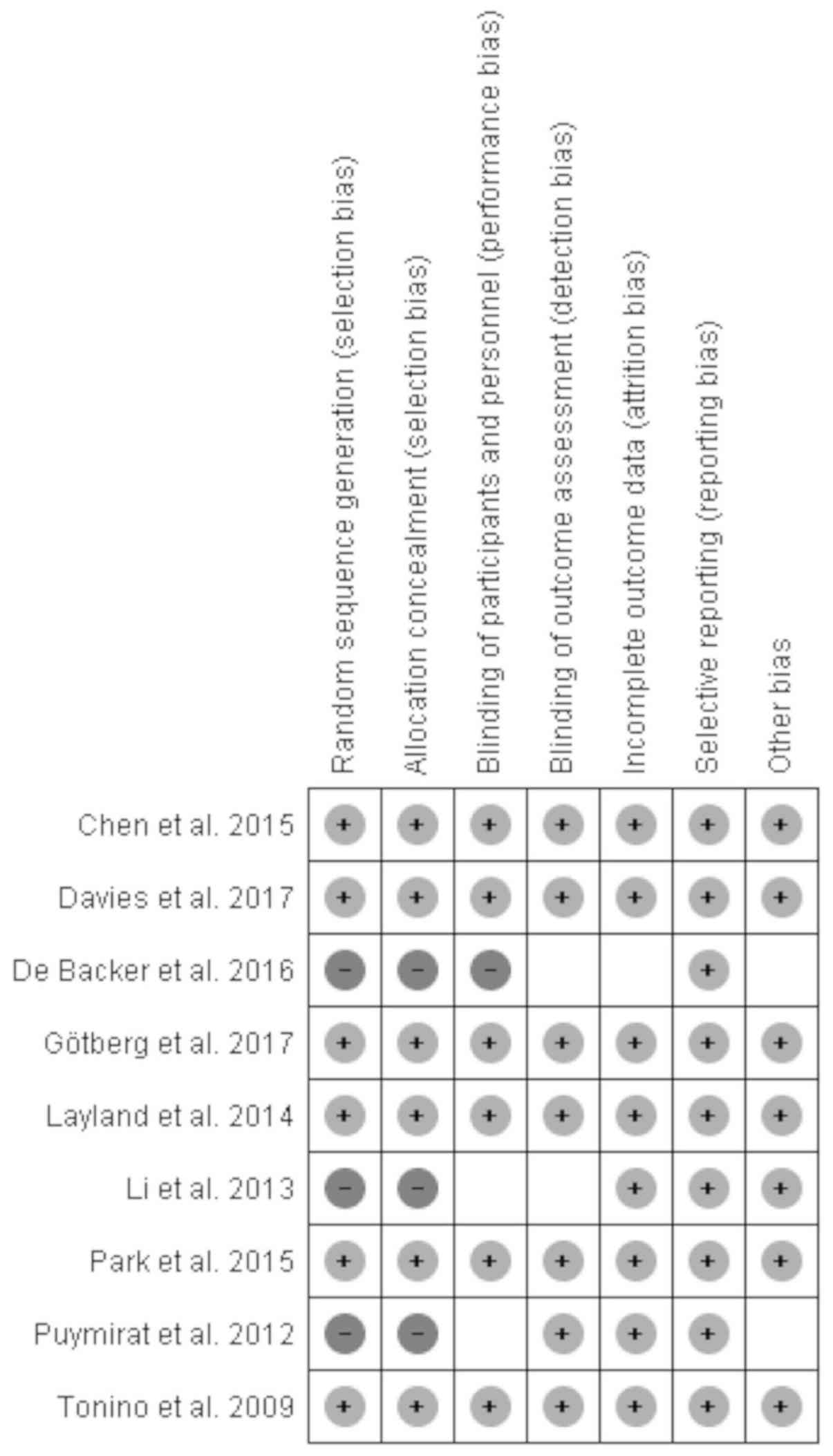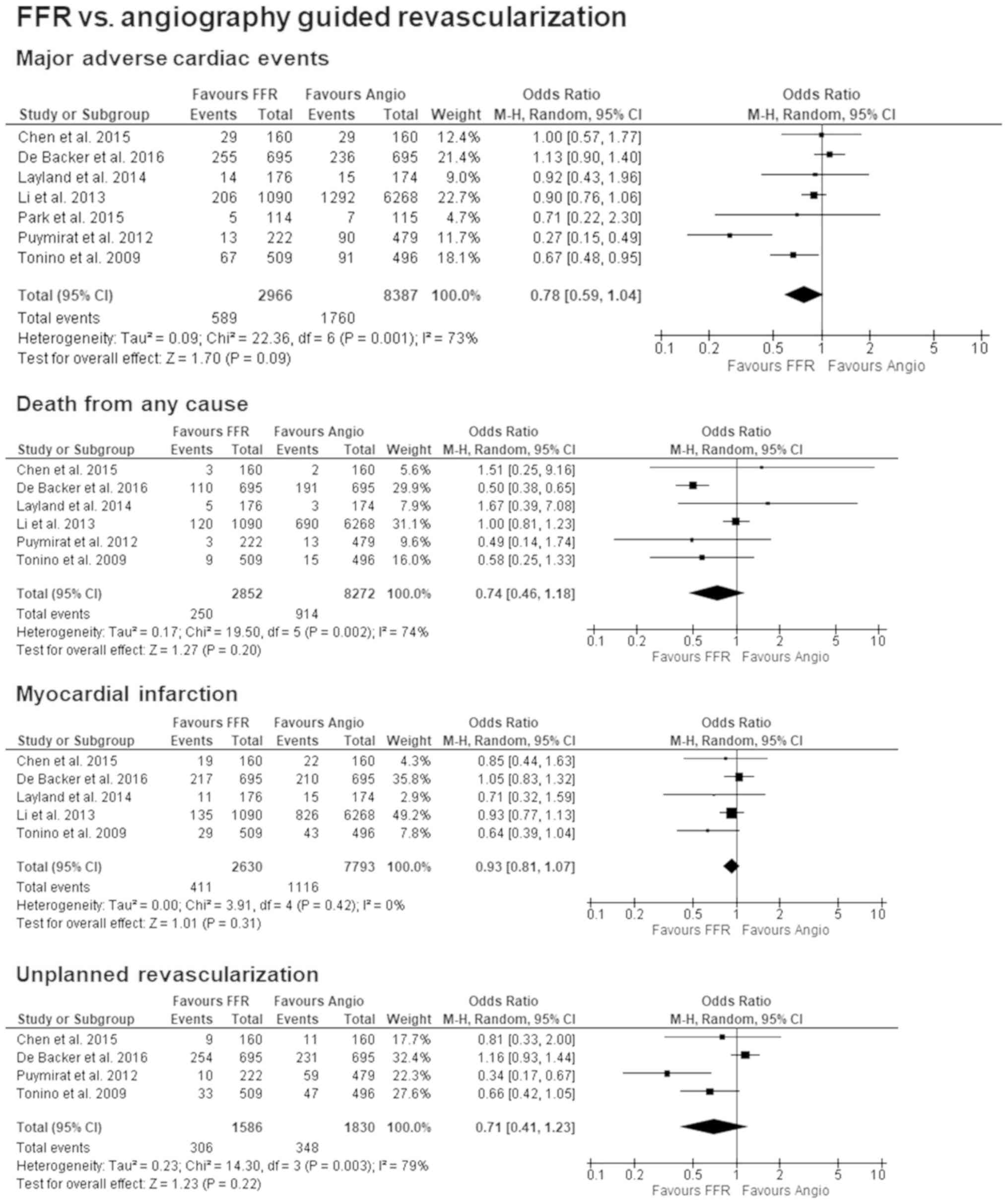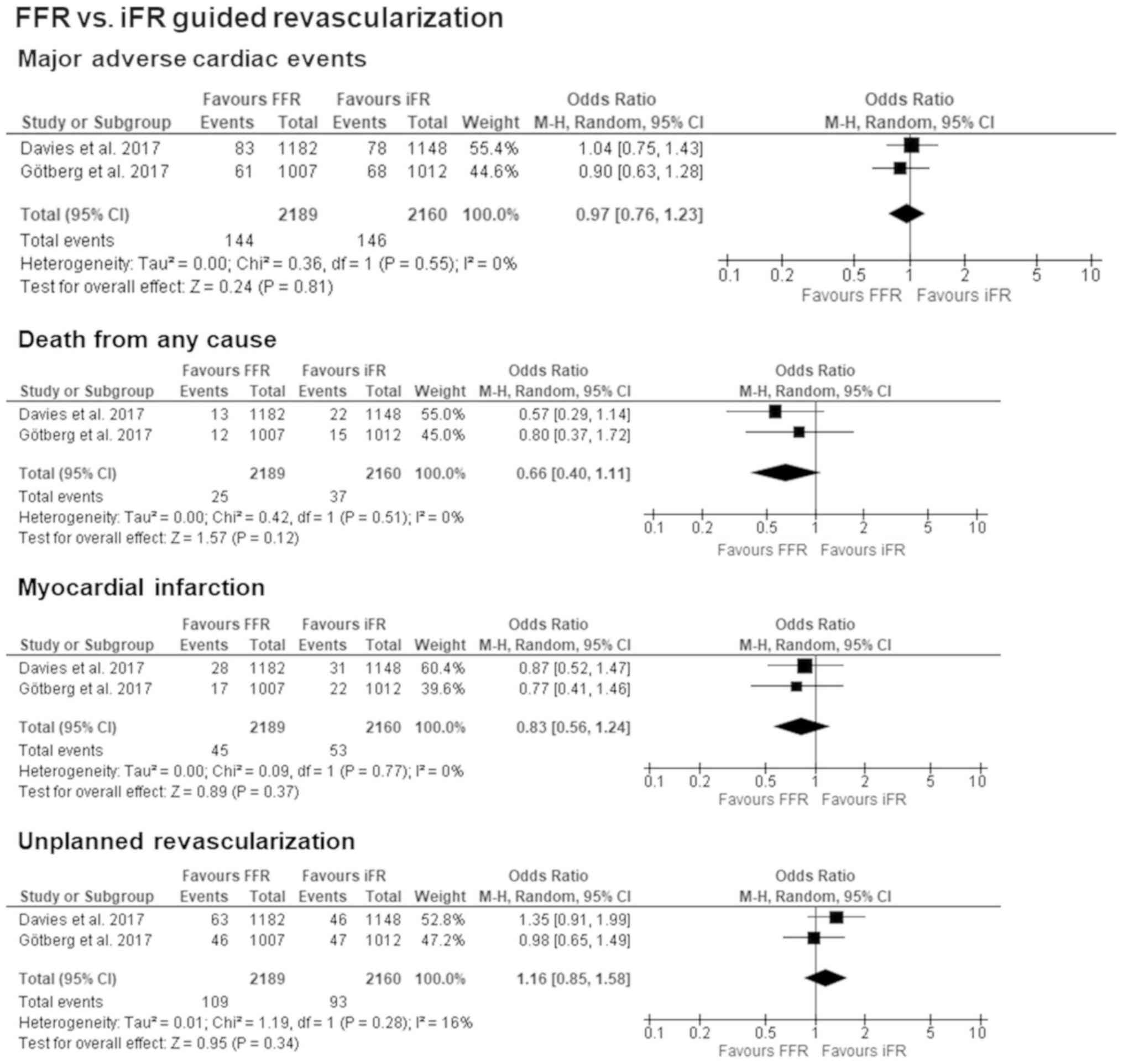|
1
|
Pijls NH, van Schaardenburgh P, Manoharan
G, Boersma E, Bech JW, van't Veer M, Bär F, Hoorntje J, Koolen J,
Wijns W and de Bruyne B: Percutaneous coronary intervention of
functionally nonsignificant stenosis: 5-year follow-up of the DEFER
study. J Am Coll Cardiol. 49:2105–2111. 2007. View Article : Google Scholar : PubMed/NCBI
|
|
2
|
De Bruyne B, Pijls NH, Kalesan B, Barbato
E, Tonino PA, Piroth Z, Jagic N, Möbius-Winkler S, Rioufol G, Witt
N, et al: Fractional flow reserve-guided PCI versus medical therapy
in stable coronary disease. N Engl J Med. 367:991–1001. 2012.
View Article : Google Scholar : PubMed/NCBI
|
|
3
|
Authors/Task Force members, ; Windecker S,
Kolh P, Alfonso F, Collet JP, Cremer J, Falk V, Filippatos G, Hamm
C, Head SJ, et al: 2014 ESC/EACTS Guidelines on myocardial
revascularization: The Task Force on Myocardial Revascularization
of the European Society of Cardiology (ESC) and the European
Association for Cardio-Thoracic Surgery (EACTS)Developed with the
special contribution of the European Association of Percutaneous
Cardiovascular Interventions (EAPCI). Eur Heart J. 35:2541–2619.
2014. View Article : Google Scholar : PubMed/NCBI
|
|
4
|
Levine GN, Bates ER, Blankenship JC,
Bailey SR, Bittl JA, Cercek B, Chambers CE, Ellis SG, Guyton RA,
Hollenberg SM, et al: 2011 ACCF/AHA/SCAI Guideline for percutaneous
coronary intervention. A report of the American college of
cardiology foundation/American heart association task force on
practice guidelines and the society for cardiovascular angiography
and interventions. Circulation. 124:e574–e651. 2011.PubMed/NCBI
|
|
5
|
Sen S, Escaned J, Malik IS, Mikhail GW,
Foale RA, Mila R, Tarkin J, Petraco R, Broyd C, Jabbour R, et al:
Development and validation of a new adenosine-independent index of
stenosis severity from coronary wave-intensity analysis: Results of
the ADVISE (ADenosine Vasodilator Independent Stenosis Evaluation)
study. J Am Coll Cardiol. 59:1392–1402. 2012. View Article : Google Scholar : PubMed/NCBI
|
|
6
|
Sen S, Asrress KN, Nijjer S, Petraco R,
Malik IS, Foale RA, Mikhail GW, Foin N, Broyd C, Hadjiloizou N, et
al: Diagnostic classification of the instantaneous wave-free ratio
is equivalent to fractional flow reserve and is not improved with
adenosine administration. Results of CLARIFY (Classification
Accuracy of Pressure-Only Ratios Against Indices Using Flow Study).
J Am Coll Cardiol. 61:1409–1420. 2013. View Article : Google Scholar : PubMed/NCBI
|
|
7
|
Petraco R, Al-Lamee R, Gotberg M, Sharp A,
Hellig F, Nijjer SS, Echavarria-Pinto M, van de Hoef TP, Sen S,
Tanaka N, et al: Real-time use of instantaneous wave-free ratio:
Results of the ADVISE in-practice: An international, multicenter
evaluation of instantaneous wave-free ratio in clinical practice.
Am Heart J. 168:739–748. 2014. View Article : Google Scholar : PubMed/NCBI
|
|
8
|
Tonino PA, De Bruyne B, Pijls NH, Siebert
U, Ikeno F, van't Veer M, Klauss V, Manoharan G, Engstrøm T,
Oldroyd KG, et al: Fractional flow reserve versus angiography for
guiding percutaneous coronary intervention. N Engl J Med.
360:213–224. 2009. View Article : Google Scholar : PubMed/NCBI
|
|
9
|
Puymirat E, Peace A, Mangiacapra F, Conte
M, Ntarladimas Y, Bartunek J, Vanderheyden M, Wijns W, De Bruyne B
and Barbato E: Long-term clinical outcome after fractional flow
reserve-guided percutaneous coronary revascularization in patients
with small-vessel disease. Circ Cardiovasc Interv. 5:62–68. 2012.
View Article : Google Scholar : PubMed/NCBI
|
|
10
|
Li J, Elrashidi MY, Flammer AJ, Lennon RJ,
Bell MR, Holmes DR, Bresnahan JF, Rihal CS, Lerman LO and Lerman A:
Long-term outcomes of fractional flow reserve-guided vs.
angiography-guided percutaneous coronary intervention in
contemporary practice. Eur Heart J. 34:1375–1383. 2013. View Article : Google Scholar : PubMed/NCBI
|
|
11
|
Chen SL, Ye F, Zhang JJ, Xu T, Tian NL,
Liu ZZ, Lin S, Shan SJ, Ge Z, You W, et al: Randomized Comparison
of ffr-guided and angiography-guided provisional stenting of true
coronary bifurcation lesions: The DKCRUSH-VI Trial (Double Kissing
Crush Versus Provisional Stenting Technique for Treatment of
Coronary Bifurcation Lesions VI). JACC Cardiovasc Interv.
8:536–546. 2015. View Article : Google Scholar : PubMed/NCBI
|
|
12
|
Layland J, Oldroyd KG, Curzen N, Sood A,
Balachandran K, Das R, Junejo S, Ahmed N, Lee MM, Shaukat A, et al:
Fractional flow reserve vs. angiography in guiding management to
optimize outcomes in non-ST-segment elevation myocardial
infarction: The British Heart Foundation FAMOUS-NSTEMI randomized
trial. Eur Heart J. 36:100–111. 2015. View Article : Google Scholar : PubMed/NCBI
|
|
13
|
Park SH, Jeon KH, Lee JM, Nam CW, Doh JH,
Lee BK, Rha SW, Yoo KD, Jung KT, Cho YS, et al: Long-term clinical
outcomes of fractional flow reserve-guided versus routine
drug-eluting stent implantation in patients with intermediate
coronary stenosis: Five-year clinical outcomes of DEFER-DES trial.
Circ Cardiovasc Interv. 8:e0024422015. View Article : Google Scholar : PubMed/NCBI
|
|
14
|
De Backer O, Biasco L, Lønborg J, Pedersen
F, Holmvang L, Kelbaek H, Arnous S, Saunamäki K, Helqvist S,
Kastrup J, et al: Long-term outcome of FFR-guided PCI for stable
coronary artery disease in daily clinical practice: A propensity
score-matched landmark analysis. EuroIntervention. 11:e1257–e1266.
2016. View Article : Google Scholar : PubMed/NCBI
|
|
15
|
Davies JE, Sen S, Dehbi HM, Al-Lamee R,
Petraco R, Nijjer SS, Bhindi R, Lehman SJ, Walters D, Sapontis J,
et al: Use of the instantaneous wave-free ratio or fractional flow
reserve in PCI. N Engl J Med. 376:1824–1834. 2017. View Article : Google Scholar : PubMed/NCBI
|
|
16
|
Götberg M, Christiansen EH, Gudmundsdottir
IJ, Sandhall L, Danielewicz M, Jakobsen L, Olsson SE, Öhagen P,
Olsson H, Omerovic E, et al: Instantaneous wave-free ratio versus
fractional flow reserve to guide PCI. N Engl J Med. 376:1813–1823.
2017. View Article : Google Scholar : PubMed/NCBI
|
|
17
|
Higgins JP, Thompson SG, Deeks JJ and
Altman DG: Measuring inconsistency in meta-analyses. BMJ.
327:557–560. 2003. View Article : Google Scholar : PubMed/NCBI
|
|
18
|
Pijls NH, De Bruyne B, Peels K, Van Der
Voort PH, Bonnier HJ, Bartunek J Koolen JJ and Koolen JJ:
Measurement of fractional flow reserve to assess the functional
severity of coronary-artery stenoses. N Engl J Med. 334:1703–1708.
1996. View Article : Google Scholar : PubMed/NCBI
|
|
19
|
Zimmermann FM, De Bruyne B, Pijls NH,
Desai M, Oldroyd KG, Park SJ, Reardon MJ, Wendler O, Woo J, Yeung
AC and Fearon WF: Rationale and design of the Fractional Flow
Reserve versus Angiography for Multivessel Evaluation (FAME) 3
Trial: A comparison of fractional flow reserve-guided percutaneous
coronary intervention and coronary artery bypass graft surgery in
patients with multivessel coronary artery disease. Am Heart J.
170:619–626.e2. 2015. View Article : Google Scholar : PubMed/NCBI
|
|
20
|
Enezate T, Omran J, Al-Dadah AS, Alpert M,
White CJ, Abu-Fadel M, Aronow H, Cohen M, Aguirre F, Patel M and
Mahmud E: Fractional flow reserve versus angiography guided
percutaneous coronary intervention: An updated systematic review.
Catheter Cardiovasc Interv. Oct 5–2017.(Epub ahead of print).
|
|
21
|
Zhang D, Lv S, Song X, Yuan F, Xu F, Zhang
M, Yan S and Cao X: Fractional flow reserve versus angiography for
guiding percutaneous coronary intervention: A meta-analysis. Heart.
101:455–462. 2015. View Article : Google Scholar : PubMed/NCBI
|
|
22
|
Bundhun PK, Yanamala CM and Huang F:
Comparing the adverse clinical outcomes associated with fraction
flow reserve-guided versus angiography-guided percutaneous coronary
intervention: A systematic review and meta-analysis of randomized
controlled trials. BMC Cardiovasc Disord. 16:2492016. View Article : Google Scholar : PubMed/NCBI
|


















